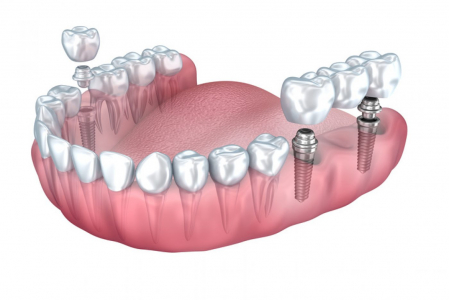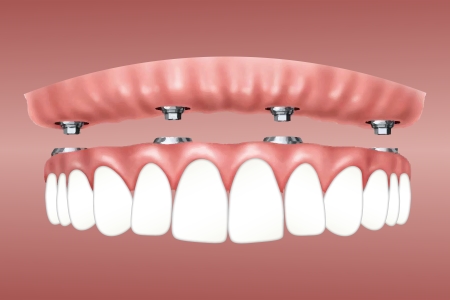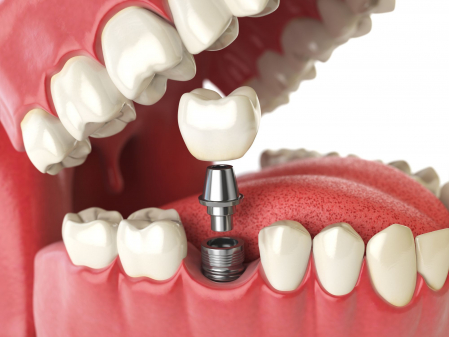Dental implants
Do you have a missing tooth? A dental implant is a permanent solution for replacing a missing tooth. One or more teeth can be replaced with implants. We also offer immediate implant placement, where the implant can be placed during the same visit where the tooth is removed. Book a time for an implant consultation online or by calling our booking number 09 838 7030.
What is a dental implant?
When we talk about a dental implant, we often mean an entity in which the artificial root attached to the bone serves as a platform for various prosthetic solutions. The implant itself is an artificial root attached to the jawbone, usually made of titanium. It adapts and attaches to the surrounding jaw in a few months. A prosthetic dental part is attached to the implant, for which there are several different solutions such as crowns, bridges or loose prostheses.
Dental implants have a decades-long history, and today, replacing a missing tooth is a routine dental treatment. 24,000 to 35,000 dental implants are installed in Finland every year. In 2018, approximately 144,900 dental implants were registered in Finland. Today, dental implant registration is no longer mandatory.
What can be replaced with a dental implant?
Implants can be used to prosthetically replace one or more teeth (Figure 1). The entire denture of the toothless jaw can also be replaced with an implant-attached bridge, or the prosthesis can be attached to the implant root (Figure 2).

Figure 1.

Figure 2.
How much does a dental implant cost?
The price of a dental implant varies depending on the client's initial situation, the type of treatment chosen and the implant used. At KotiHammas, the starting price of an implant (screw + dental crown) is 1890 euros. Before starting the actual implant treatment, the client should visit a dentist for a more detailed cost estimate of the treatment.
Implants are installed at KotiHammas clinics in Helsinki, Tikkurila, Järvenpää and Turku.
Who can get implants?
- There should be enough bone in the implantation area. If necessary, bone can be added with bone grafts or artificial bone.
- General health must be good enough. For example, unbalanced diabetes or tobacco dependence may prevent treatment. For a patient with diabetes, implant treatment can be given if the disease is in balance.
- Oral health must be good enough, and there should be no periodontal disease of the teeth, for example.
- Oral hygiene must be good enough. Implants require regular, careful cleaning.
- Implants will not be attached if jaw growth is still in progress.
The above will be ensured through consultation.
How does implant treatment progress?
The client should first have an implant consultation with the dentist performing the treatment. At the consultation, the dentist examines the mouth and takes X-rays, based on which they plan the treatment with the client. You can leave a call reques for a consultationt here. A consultation appointment should always take place before starting the treatment, unless an assessment has been made during other treatments.
Phases of implant therapy
1. Treatment planning consultation visit and cost estimate
Dental examination, X-ray of the whole jaw and comprehensive treatment planning with the patient. At the consultation, the costs of treatment will also be determined.
2. Implant placement
The visit following the consultation is when the implant is placed. The surgical procedure is initiated by making an incision at the site where the implant is to be placed. This allows the gingival flaps to be separated and gives access to the jawbone. Once the jawbone is exposed, the dentist drills an opening in the bone where the implant can be placed. Different sizes of drill bits can be used in the procedure to make the opening exactly match the implant to be installed. When drilling, the dentist checks that the hole is of the correct shape. The drill is marked with dimensions, from which the dentist determines the correct depth of the drilled hole.
After drilling, special grooves corresponding the implant are created in the opening so that the implant sits firmly in place. Once the drilling and preparations are complete, the implant screw can be installed.
Implant screws have options where the length and diameter of the screw can be selected individually to suit the patient. The amount of bone in the area to be implanted determines the appropriate size screw for the patient. In general, the largest possible screw is chosen, because a longer fastener with a larger diameter can withstand the pressure applied to it better, for example when the teeth are bitten together.
After implant placement, the dentist installs a temporary healing screw over the implant, after which the doctor sutures the gingival tissue back into place. The stitching is often left in place for 7-10 days to allow the stitching area to heal in peace. We strive to use dissolvable stitches that don’t need to be removed.
3. Osseointegration
Osseointegraation is the structural and functional fusion of the bone and artificial implant.
The time it takes to heal and connect is completely patient-specific. The healing time depends on the workload, such as the amount and density of bone operated and the size of the implant. Generally, the implant is given about 2-4 months to osseointegrate.
Sufficient time must be allowed for the healing area to heal, as the fusion of bone and the implant is a prerequisite for the future dental crown to be installed in line with the patient's own teeth. It is not a good idea to strain the implant in the bone during the healing phase to ensure adequate ossification. If necessary, a temporary crown or a removable small partial prosthesis can be made at the implantation site to fill the gap in the row of teeth. The implantation site may also be without temporary structures during the healing period.
4. Installation of the prosthetic part
Paranemisvaiheen jälkeen poistetaan implanttiruuvin päällä ollut väliaikaisrakenne, ja kohtaan asennetaan hetkeksi sopivankokoinen jäljennin. Tämän jälkeen suusta otetaan molemmista leuoista jäljennökset sekä purentaindeksi, joka kertoo proteesin valmistavalle laboratoriolle implantin asennon suhteessa muuhun hampaistoon. Jäljennin ja jäljennökset lähetetään hammaslaboratorioon, ja väliaikaisrakenne laitetaan tuoksi ajaksi vielä takaisin implantin suojaksi.
Once the merging of the bone and implant is complete and the implanted area has healed, the final prosthetic part can be made to replace the missing tooth. The final product can be, for example, a dental crown, a bridge or a prosthesis, i.e. dentures.
After the healing phase, the temporary structure on top of the implant screw is removed and a suitably sized replicator is momentarily installed. Impressions of both jaws are then taken from the mouth, along with a bite index that tells the prosthetic laboratory the position of the implant relative to the rest of the dentition. The jaw impressions and replicator will be sent to the dental laboratory, and the temporary structure will be put back in for the implant to protect it.
5. Post-treatment monitoring
New implant teeth require the same treatment as your own teeth. The dentist will schedule a follow-up so that the condition of the implant is checked regularly.
Required visits to the dentist's office for a dental implant
1. Planning
2. Surgical procedure, implant placement
3. Taking an impression for the prosthetic solution (approximately 2-4 months after surgery).
4. Installing the prosthetic solution (approximately 1 month after taking the impressions).
5. Follow-up appointment (approximately 1 month after installing the prosthetic solution).
In addition to these, regular follow-up visits are scheduled.
At KotiHammas, we use high-quality Osstem implants. Osstem has become the most widely used implant brand for dentists worldwide. Read more about the implant manufacturer and materials here.
Book an appointment for an implant consultation online or by calling our booking number 09 838 7030.

